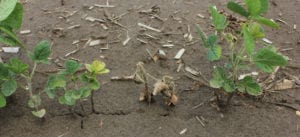By Louis Sutton
AgVenture Regional Product Manager & Agronomy Lead
Well, it happened again: we had a week of warm weather and planting started, then cool spring rains and colder temperatures hit again, dropping our soil temperatures back to 41 degrees. So, what do we need to look at with seed in the ground below the temperature needed to emerge?

Seed corn maggot damage to corn.
First, there are a lot of insects in the seed zone. Some of those insects include Seed Corn Maggots, Wireworms, and even False Wireworms. Even with superior seed treatments, the insects still must feed to get the treatment and that opens a wound which allows the pathogens into the seedling. That will cause issues early and late in the season. For now, the soil is cool enough that the insects can stay in the seed zone all day long. As the soil warms, they move deeper into the soil or morph into adults and cause fewer issues. Seed Corn Maggots feed on the seed and allow the damping off diseases to enter and rot the seed. The seed treatment controls the maggots, but the damage may already be done. Wireworms also feed on the seed and the mesocotyl. This is also what a False Wireworm does, but it becomes a bigger issue as seed treatments do not protect from a False Wireworm attack. False wireworms will need to be treated or you will need to rely on warmer weather to cycle them out or drive them down into the soil. Plus, the faster seed emerges, the healthier the plant is and should be the rest of the year.

Damping off caused by Rhizoctonia seedling blight and root rot. (Photo M. Chilvers.)
The next issue to address is damping off. As the seed is in the ground ready to emerge, all the pathogens are attacking the seedling. The faster that seedling can emerge, the better off you will be. The pathogens can kill the seedling early and cause poor stands or replant issues. Pathogens also reside in the plant and continue to build until the plant goes under the stress of reproduction. At this point, the pathogens can attack and cause the plant to die or lodge before harvest. So, what is damping off? It is a group of pathogens that gets a common name, as without lab tests it is hard to tell them apart early in the season. A few examples include Pythium root rot and Rhizoctonia root rot. Pythium root rot occurs with cooler temperatures in poorly drained soils. The lower portion of the stem may become slimy and black. Rhizoctonia root rot occurs with moderate moisture levels in warm to hot temperatures.
The best option is to plant in warm soils, so the seedling can emerge quickly. There are basically two times a year when you can most control what happens to your yields. One of those times is planting and the other is harvest. Don’t lose yields by being in a rush to plant this spring. Follow the Maximum Profit System™ planting guide to achieve success and add bushels to your bottom line.